Quick Airline Information:
✈Airline IATA* code: EK
✈Airline ICAO* code: UAE ✈Founded: 25 March 1985 ✈Website: www.emirates.com✈Alliance: None✈History
✈Operations and Destinations 🌍
✈Fleet ✈️
✈Photo Slide 📷✈Safety Video 🎬
✈Airline reviews ⭐
*IATA: (International Air Transport Association)
*ICAO: (International Civil Aviation Organization)
History Menu:
Emirates is now the world's fourth-largest airline by scheduled revenue passenger-kilometres flown and number of international passengers carried. It was founded in 1985 by the royal family of Dubai. The airline's first flight was from Dubai to Karachi, Pakistan, in October of that year. Its first aircraft stock came in the form of a pair of Boeing 727-200s provided by the Dubai Royal Air Wing. The airline grew rapidly through partnerships and investment to become one of the world's leading air carriers.
Its origins can be traced back to the mid-1980s, when Gulf Air began to cut back its services to Dubai as it was concerned it was providing regional feeder flights for other carriers. As a result, Emirates airline was conceived in March 1985 with investment by the Royal Family of Dubai. In the mid1980s, Pakistan International Airlines also played a large role in establishing the Emirates airline by providing technical and administrative assistance to the new carrier as well as leasing a new Boeing 737–300 and an Airbus A300B4-200. The Royal Family's Dubai Royal Air Wing also provided the airline with two additional used Boeing 727–200 to expand further operations.
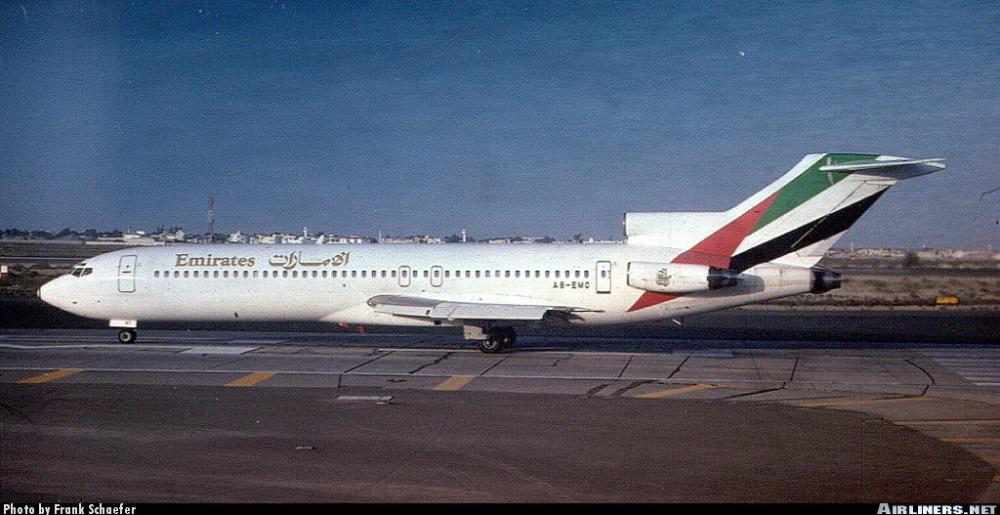
Maurice Flanagan, who previously worked at British Airways, Gulf Air, and BOAC, was appointed chief executive officer of the new airline. To highlight the airline's early success, Gulf Air, during Emirates' first year of operations, suffered a 56% drop in profits, and a loss the following year. By 1986, the airline had added destinations such as Colombo, Dhaka, Amman and Cairo to its route network. In 1987, a second Boeing 727 was purchased from the Dubai Government and an A300 was temporarily replaced by a second example from Kuwait Airways.
On 3 July 1987, Emirates received its first bought aircraft, an Airbus A310 and with two examples, launched daily non-stop services to London Gatwick on 6 July the same year. The airline in 1987 added Frankfurt via Istanbul, and Malé (Maldive). By the end of 1987, Emirates was serving 11 destinations. This was followed by an expansion into the Far East market in 1989, with flights to Bangkok, Manila and Singapore and Hong Kong in 1991.
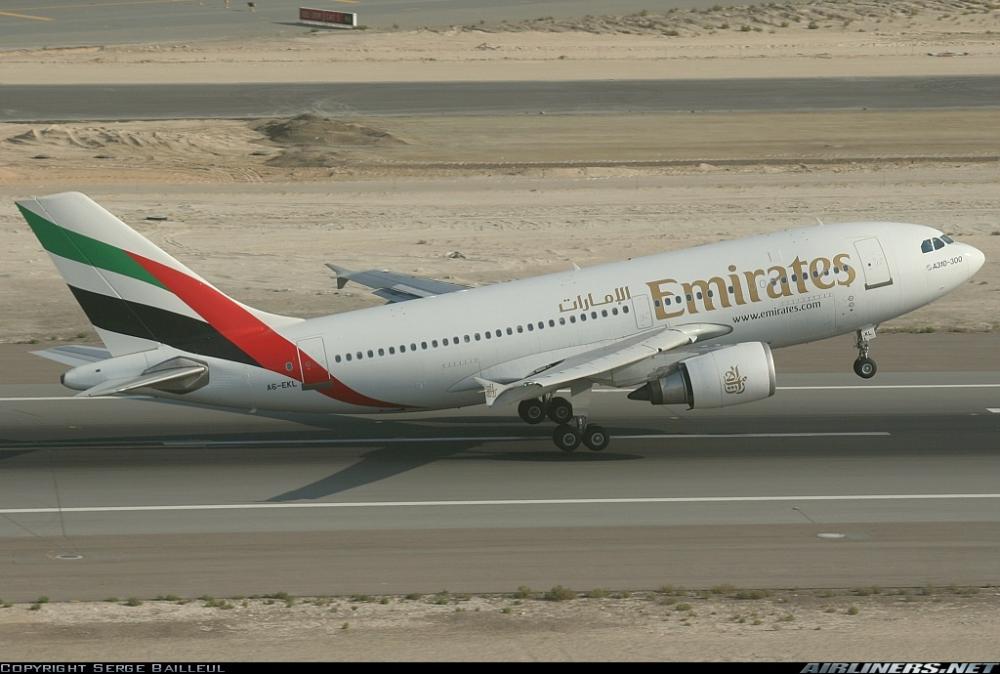
Emirates continued to expand during the late 1990s. The growing cargo business accounted for 16 percent of the airline's total revenues. Emirates started offering round-the-world services from autumn 1993, after a partnership was established with US Airways. By 1995, the airline expanded the fleet to six Airbus A300s and eight Airbus A310s and built the network up to cover 37 destinations in 30 countries.
In 1996, the airline received its first Boeing 777–200 aircraft, and was followed shortly thereafter by six Boeing 777-200ERs. The arrival of the 777s allowed Emirates to continue its Singapore service onward to Melbourne commencing in 1996. In 1998, Emirates Sky Cargo was launched. Although the Emirates had always provided a cargo service using capacity within its passenger aircraft, this was now expanded with an aircraft, crew, maintenance and insurance lease with Atlas Air, initially for a single Boeing 747–200 freighter.
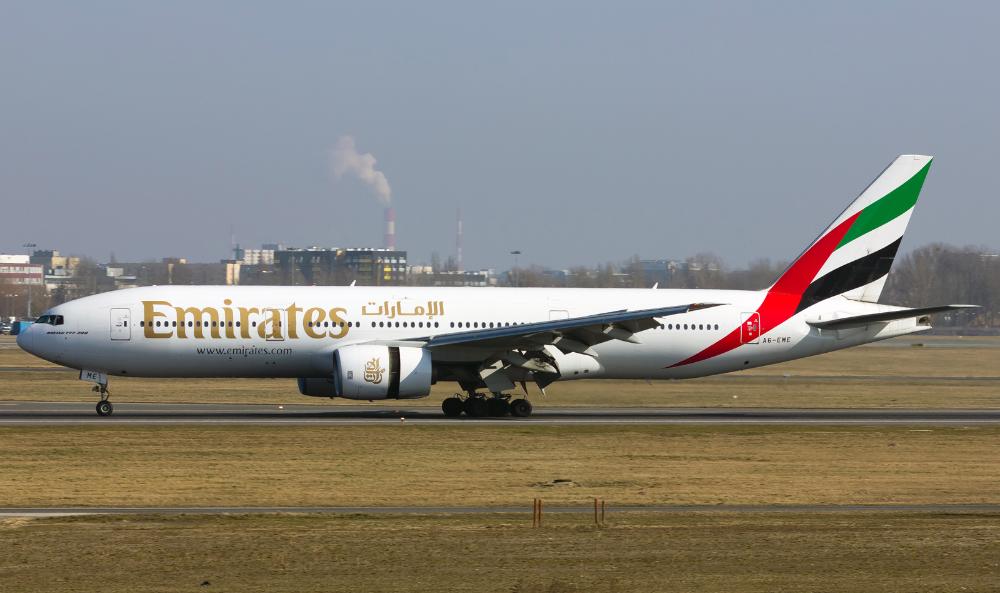
In May 1998, Emirates paid the Government of Sri Lanka for a 43.6% stake in SriLankan Airlines Emirates subsequently sold its stake in the airline to the Government of Sri Lanka, that was finalised in 2010. In 2000, Emirates placed an order for twenty five Boeing 777-300s, eight Airbus A340- 500s, three Airbus A330-200s and twenty-two of the double-decker A380. The first A330-200 arrived in 1999 and leased A340-300 in 2003.
Its frequent flyer programme, Skywards, was also launched in 2000 as the airline grew. The financial year 2001–02 would prove to be very difficult for Emirates and one of the toughest for the airline. Initially sales were affected by a recession and later influenced by the bombing of Colombo Airport. The bombing destroyed three of SriLankan Airlines' twelve aircraft and damaged three other aircraft.
A few months later, the September 11 attacks in New York City saw thousands of cancellations and deferments of travel plans. The airline announced a recruitment freeze, but did not make any redundancies. The airline also reduced flight frequencies to other destinations. At the 2003 Paris Air Show, Emirates signed an order for 71 aircraft. The order included firm purchase orders for a further 21 Airbus A380-800s and lease orders for two A380- 800s.
In 2004, Emirates began flying non-stop to New York City's John F. Kennedy International Airport using its new Airbus A340-500. These flights meant the resumption of non-stop air services between the United Arab Emirates and the United States, after Delta Air Lines withdrew its flights.
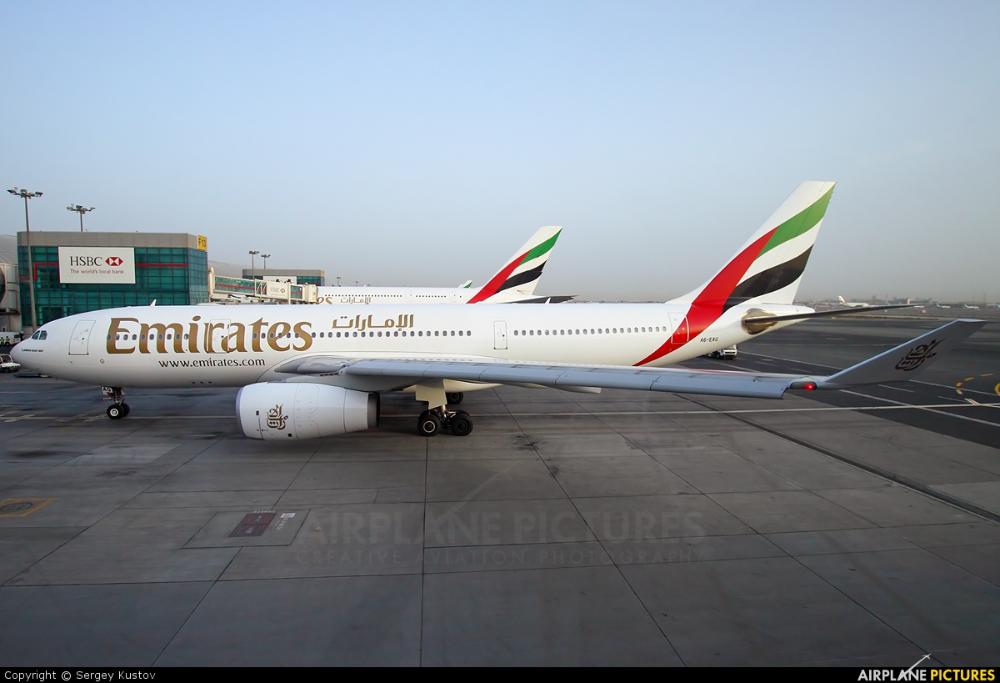
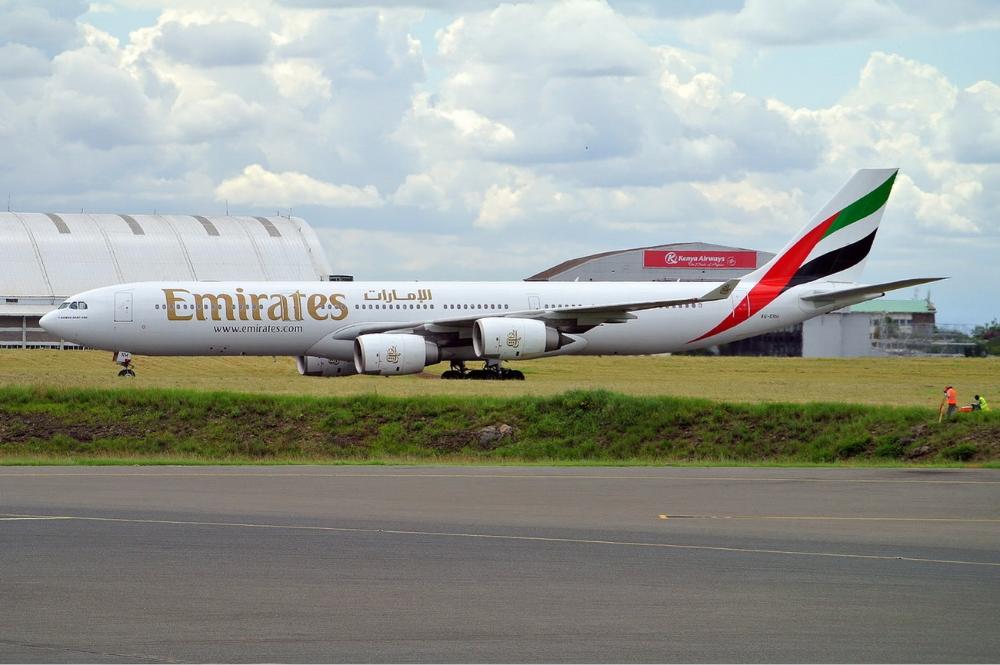
In 2005, Emirates ordered 42 Boeing 777s, the largest Boeing 777 order in history. In 2007, the airline signed contracts for 120 Airbus A350s, 11 A380s and 12 Boeing 777-300ERs. Also in 2007 by opening flights to São Paulo in Brazil, Emirates began the first non-stop flight between the Middle East and South America.
Emirates, took delivery of the first A380-800 in August 2008 and flew its first revenue flight from Dubai to New York City-JFK. Emirates went on to be the largest carrier to operate the A380 with a total of 90 orders until 2010. Emirates announced it does not expect to retire early airframes before 2020.
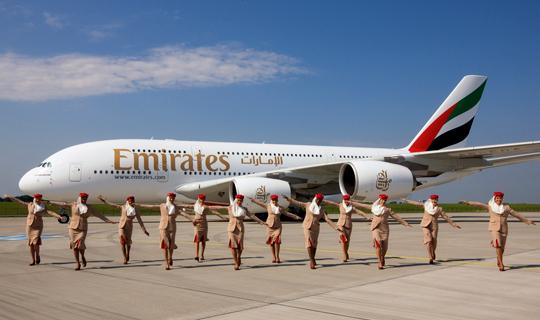
In 2009, Emirates became the world’s largest operator of the Boeing 777 with the delivery of its 78th example of the type. In 2010, Emirates said it planned to operate over 120 Airbus A380s when new airport space is available. The target implied a future Emirates order for 30 A380s.
In 2010, at the Farnborough Airshow, the airline placed an order for 30 Boeing 777s. In 2011, again Emirates placed another order for another 50 777s. The growth of Emirates has drawn criticism from carriers such as Lufthansa and Air Canada, who claim Emirates has unfair advantages. Emirates has not been given more landing rights in Canada beyond Toronto, and has been denied expansion to Calgary and Vancouver. In Germany, it’s not able to fly to Berlin nor to Stuttgart due to the same landing rights.
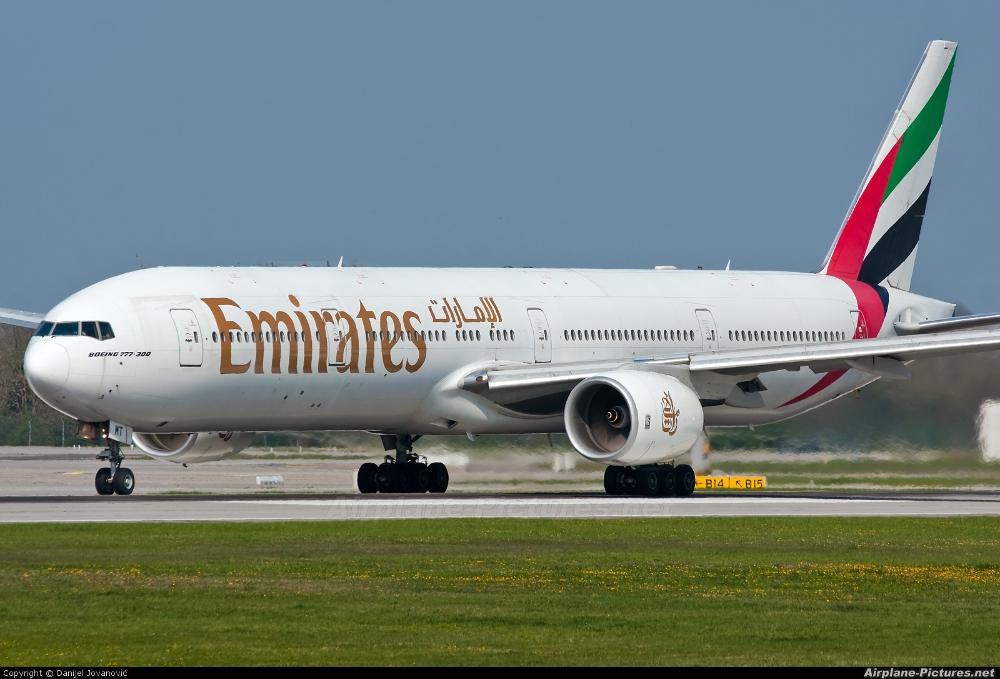
On 6 September 2012, it was announced Emirates and Qantas had signed a 10-year agreement to set up a major alliance, which would see Qantas move its hub for its European flights from Singapore to Dubai International Airport and end its 17-year revenue-sharing agreement with British Airways on the services between Australia and Britain. Qantas began daily Airbus A380 services from both Sydney and Melbourne to London via Dubai, meaning that together the two airlines were providing 98 weekly flights between Australia and the Emirates hub. Qantas became the only other airline operating at Terminal 3 at Dubai International Airport.
At the 2013 Dubai Air Show, Emirates made aviation orders history with an order for 150 Boeing 777X and 50 Airbus A380 aircraft, bringing the overall order total to 140 A380's. The airline announced its plans to move all operations to Dubai World Central - Al Maktoum International Airport sometime after 2020.
On November 12, 2017, Emirates Airline agreed to buy a number of Boeing's 787 Dreamliners . With the first deliveries planned for 2022, the deal included 40 of the new 787-10, the largest available Dreamliner. On 18 January 2018, it was reported that Emirates had placed an order for 20 A380s with options for 16 more with deliveries to start in 2020.
In 2014, Emirates launches flights to Boston, its 8th gateway in the USA, it also becomes the first airline to offer a scheduled A380 service at London Gatwick. In 2016, Emirates introduces 6 new destinations in its global network Yangon, Hanoi, Yinchuan, Zhengzhou, Cebu and Clark.
History source: Wikipedia.org / Emirates.com
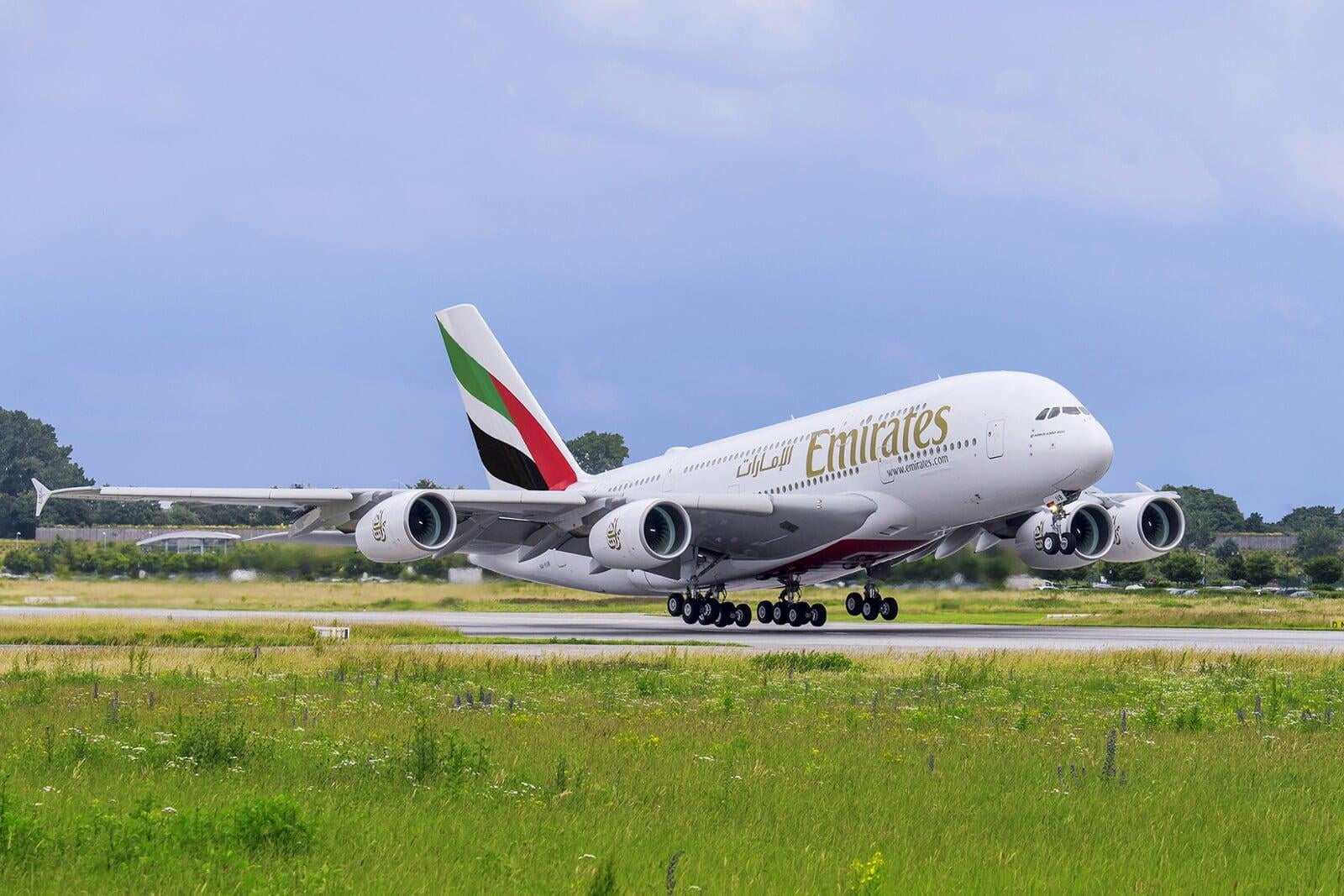
Operations and Destinations 🌍:
The airline is a subsidiary of The Emirates Group, which is wholly owned by the government of Dubai's Investment Corporation of Dubai. It is the largest airline in the Middle East, operating to more than 150* cities in 80 countries across six continents. All of its flights are based at its only hub at Dubai International Airport.(DXB). Emirates has no domestic destinations. Some of the longest international flights are to Seattle, Buenos Aires, Christchurch or Auckland taking at least 14 hours to complete.
The Dubai is a major connecting hub with 75% of passengers connecting to an onward flight. Terminals are large and spacious operating 24h a day.
Emirates' financial success has been attributed to rapid growth in demand for air travel in the Middle East, Africa and Between Europe and Asia; the airline's investment in state-of-the-art aircraft, and the availability of creating routes which increase on capacity over demand has been key on building its growth.
Emirates flies to the following destinations*:
| Region 🗺️ | Destinations 🌍🌎🌏 |
|---|---|
| ✈The MIddle East | Amman, Dubai, Baghdad, Basra, Beirut, Dammam, Doha (Suspended), Jeddah, Kabul, Kuwait City, Manama, Mashhad, Medina, Muscat, Riyadh, Tehran |
| ✈Africa | Abidjan, Abuja, Accra, Addis Ababa, Algiers, Cairo, Cape Town, Casablanca, Colombo, Conakry, Dakar, Dar es Salaam, Durban, Harare, Johannesburg, Kampala, Khartoum, Lagos, Luanda, Lusaka, Mahé, Nairobi, Port Louis, Tunis |
| ✈Europe and Russia | Amsterdam, Athens, Barcelona, Birmingham, Bologna, Brussels, Budapest, Copenhagen, Dublin, Düsseldorf, Edinburgh, Frankfurt, Geneva, Glasgow, Hamburg, Istanbul, Larnaca, Lisbon, London, London (LHR, LGW, STN), Lyon, Madrid, Manchester, Milan, Moscow, Munich, Newcastle upon Tyne, Nice, Oslo, Paris, Prague, Rome, Saint Petersburg, Stockholm, Valletta, Venice, Vienna, Warsaw, Zagreb, Zürich |
| ✈Asia | Ahmedabad, Bangkok, Beijing, Bengaluru, Cebu, Chennai, Clark, Delhi, Denpasar, Dhaka, Guangzhou, Hanoi, Ho Chi Minh City, Hong Kong, Hyderabad, Islamabad, Jakarta, Karachi, Kochi, Kolkata, Kuala Lumpur, Lahore, Malé, Manila, Mumbai, Osaka, Peshawar, Phnom Penh, Phuket, Seoul, Shanghai, Sialkot, Singapore, Taipei, Thiruvananthapuram, Tokyo (NRT, HND), Yangon |
| ✈North America | Boston, Chicago, Dallas, Fort Lauderdale, Houston, Los Angeles, New York City, Newark, Orlando, San Francisco, Seattle, Toronto, Washington, D.C. |
| ✈South America | Buenos Aires, Rio de Janeiro, São Paulo, Santiago de Chile |
| ✈Australia and New Zealand | Adelaide, Auckland, Brisbane, Christchurch, Melbourne, Perth, Sydney |
*Destination list is for reference only. Please check directly with the airline for updates.
*Note some destinations are only seasonal.*Correct info as of Nov 2018.
Fleet ✈️:
The Emirates fleet consists entirely of wide-body aircraft. As of August 2018, Emirates operates a fleet of more than 250 aircraft. Emirates operates the largest fleets of Airbus A380s and Boeing 777s in the world. The airline also has 115 777-9s and 35 777-8s or order. Emirates has had no narrow-body aircraft in its mainline fleet since 1995.
The Airline uses a smart but effective way to calculate market demands; first any new route is inaugurated with slightly smaller aircraft, such as the B-777-200/300 and as demand increases the aircraft will gradually be replaced by Airbus A380-800. This aircraft is the airline’s flagship plane which is the most popular aircraft to fly with. Emirates is the largest operator of the type in the world with 108 examples of the A380 up to 2018 in service, with new planes arriving every couple of months to keep the fleet young.
The Emirates fleet* consists of the following aircraft:
| Network 🌐 | Aircraft ✈️ |
|---|---|
| ✈Medium and Long haul. (All International destinations) | Boeing 777-200, B777-300ER. Airbus A380-800 |
*Correct fleet info as of Nov 2018.
Emirates Photo Slide 📷:
Emirates Safety Video (A380) 🎬:
Reviews ⭐:
 |  |
|---|---|
| ✅Good connections from Europe to Asia and Australia/New Zealand. | 👎Not part of any global alliance. |
| ✅Convenient times of departure and short connecting times in Dubai. | 👎Fares are expensive if not bought in promotion. |
| ✅Modern and reliable fleet of aircraft. Most modern planes used in the industry: A380-800 and Boeing 777-300. | 👎No upper deck economy seating on A380 planes. (except high density routes in the middle east) |
| ✅Good on-board entertainment. Charging sockets and wide LCD monitors with live flight video cameras. | |
| ✅Excellent on-board service. Multinational cabin crew. | |
| ✅Online Check-in and seat allocation in advance (free). | |
| ✅Good baggage allowance. (Economy 30kg) |

.png)












.png)